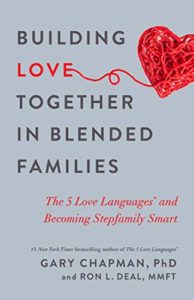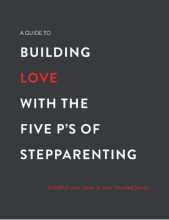Excerpt:
Dr. Gary Chapman: As parents or stepparents, we cannot control their behavior, but we can continue to reach out in love to them. Ultimately, love wins even if they don’t ever, you know, warm up to you. They’re still going to move into adulthood remembering the way you did reach out to them in love.
End of Excerpt
John Fuller: That’s Dr. Gary Chapman and he’s our guest today on Focus on the Family, along with his co-author, Ron Deal. I’m John Fuller and your host is Focus president and author, Jim Daly.
Jim Daly: John, odds are people in the audience know someone who has a stepchild. And according to recent statistics, 40% of families in the United States are blended families. If you’re dating or married with stepchildren, you know marriage in a stepfamily comes with its own unique issues. You face challenges biological families just don’t have to think about, like finding your role as a stepparent and maybe helping siblings become comfortable with one another and connecting with adult stepchildren you might not see very often. So, all that makes it difficult. Remember, here at Focus on the Family, we want to help you with those relationships because we want your family to be as healthy as it can be. So, today we’re going to encourage you and provide some tools to cultivate a loving, blended home. It’s not easy, but you can achieve a sense of unity in your family with faithful love and firm commitment to your spouse.
John: And as I mentioned, Dr. Gary Chapman and Ron Deal are here. Dr. Chapman is the author of the bestselling series The Five Love Languages. And Ron Deal is a leading expert on blended families. Together, they’ve written the book, Building Love Together in Blended Families: The Five Love Languages and Becoming Stepfamily Smart. And, of course, we’ve got copies of that here at Focus on the Family. Just call 800, the letter A and the word FAMILY.
Jim: And I can’t think of two better people to talk about this subject than both of you. Welcome to Focus on the Family.
Gary: Thank you. We’re glad to be here.
Jim: (Laughter) It’s good to see you, Ron.
Mr. Ron Deal: We are glad to be here. Thanks.
Jim: Hey, you both have counseled blended families. I mean, that’s just part of a counselor’s workload today, right?
Ron: Yes.
Jim: Because there’s so many blended families. What are some of the most common challenges you’ve seen with those families?
Ron: I often say at the intersection of Parenting Street and Marriage Avenue in blended families, there’s a lot of t-bone collisions.
Jim: Huh.
Ron: And it’s – parenting matters and stepparenting and co-parenting and the complexities around that piece – the relationship between the stepparent and stepchildren intersects immediately with the marriage. And so, something that starts off as a parenting conversation, quickly becomes an issue in the marriage. Now, that’s true in all families. Okay? Any couple can experience it. If they get crossways with each other about their – raising their children. But what’s different in blended families is you have so many other layers to the relational dynamics that make this even more complex and it’s harder for couples to come together around parenting matters. Therefore, it’s harder for them to keep their marriage safe and protected.
Jim: And you have set it up because we’re going to really address a lot of the elements you just talked about. Ron, one of the things you have been at this table before mentioning is the slow cooker attitude in blended families. I think it’s that gold nugget in your presentation on the subject of blended family. What are you driving at with that slow cooker approach?
Ron: Ultimately, it’s looking at expectations. When husband and wife come together to form a blended family, one of their common hopes, one of their common expectations is we love each other, the family’s going to love each other, kids are going to feel safe and comfortable in this new home, stepparent’s going to come right in and not be a stepparent, be a parent. And there’s a pretty rich and understandable dream there of repairing, restoring what was been lost. Whatever the back narrative is, we want to fix it and the family’s going to do that. And so, with that comes a very high expectation that not only will it happen, but it’ll happen quickly. And typically, it just takes blended families a journey to get to that place where they do feel like family. It does feel comfortable to be with one another. And so, what we help them with this slow cooker metaphor, the crockpot metaphor is, yeah, you can get there. It’ll be good to taste someday.
Jim: (Laughter) Yeah. Right.
Ron: But like cooking with a crockpot, it takes hours in a crockpot, years for the average blended family to really ultimately feel like family. But if you go in with a blender mentality, a microwave mentality, of “we’re gonna cook this sucker fast and it’s gonna be great and everybody’s going to love it,” then you get disappointed and you feel like you’re a failure because six months, a year, year and a half, three years, you’re going, “Okay. We’re not getting anywhere. My step kids just still doesn’t like me. What’s wrong with us?” No, no, no. It’s okay. Hang in there, right? Keep pressing on. Just like with a crockpot, you will get there. But if you quit cooking, if you give up on it, if you feel like a failure and you start saying, “Okay, I’m done. I don’t know how to do this” – well, then everything completely unravels, and you stop cooking, right? That’s not going to help anymore.
Jim: Yeah. Well, it’s so true. Gary, describe how different definitions of love and levels of motivation can complicate relationships in this context.
Gary: Yeah, well, I think, you know, we have different ideas on what a loving relationship would look like. If you’re the parent, you’ve got a mental image of what it’s going to look like when I love this stepchild and this stepchild loves me.
Jim: Right.
Gary: But the stepchild has a totally different idea, probably, in terms of what that would look like. And many times they’re not motivated to love you because they may still be attached to their former mom or their former dad, and they’re not really ready for what you picture in your mind. And, you know, Ron, I think what you just described, most couples at least that I deal with, do go in with the idea that this is going to be a quick thing.
Ron: Yes.
Gary: It’s going to really happen.
Jim: That sounds like an adult attitude.
Gary: Yeah. Yeah.
Jim: You can fix this. Let’s do this. And that’s the problem, right?
Gary: Yeah. And that’s why I think if they understand, it might take a few years…
Jim: Right.
Gary: …I said years for this to happen – then they’re more likely to be patient with the process.
Ron: It’s kind of the equivalent of going back to your crockpot and going, “It’s been two hours. Come on, food. What’s going on?”
Jim: Don’t make a crockpot a microwave.
Ron: Exactly. You can’t – it’s not an Instapot. (Laughter)
Jim: Well, let’s get to that, because that patience factor is really critical. So, you’ve got to be patient is what I’m hearing you say. And that can be frustrating at times. I think impatience can be the root of a lot of problems in marriage.
Ron: And so, adjusting your expectations is really helpful. It’s not that you’re a failure. You’ve done something wrong. You’ve – we should have never done this. It’s not any of those things. It’s this is a journey. It’s just a little longer to get there than we thought. And we need to continue to press in, but do so with a lot of smart, a lot of wisdom. For example, what does patience look like? So, for a stepparent, one application would be that I change my expectations so that if I do something kind for the child, I’m not necessarily living with the hope that they’re going to turn right around – “I loved you with your love language. You’re gonna love me with my love language, right?” Now, that’s a blender expectation. A crockpot expectation would be – “No, I just lead with love and I do what’s right by you. And I’m praying and holding on that someday you might feel comfortable enough to return that to me.”
Jim: And I don’t mean to be simplistic with this, but you’re the adult in the room, too. I mean, especially if you’re dealing with younger stepchildren, you need to demonstrate what it means to be unconditionally loving – right? – for them to understand it. You brought up the love languages. So, Gary, whenever you’re here…
(LAUGHTER)
Jim: …We’re having you give us the quick tutorial on the five love languages. A brilliant concept, by the way…
Gary: (Laughter).
Jim: …That the Lord laid in your heart. How many years ago?
Gary: Ooh. The book came out originally, the original book, 1992.
Jim: And it’s sold like a bazillion copies.
Gary: (Laughter).
Ron: Yeah.
Jim: And, uh, – but it was – it was one of those – you know, occasionally an author really hits a theme that everybody connects to and people have connected with love languages because you observed something and put it down in writing. Describe those five love languages.
Gary: Well, you know, the basic idea is that what makes one person feel loved will not necessarily make another person feel loved. And that’s true whether it’s a blended family or a biological family. And so, what we discovered is that there’s fundamentally five basic ways to express love on emotional level so that we meet that deep emotional need of adults and children to feel loved. One of them is words of affirmation. You know, just positive comments about them, the way they look, something they’ve done, anything. But you’re just giving them positive words. All of us appreciate that. But for some people, that is what makes them feel loved.
Jim: Can I ask you a quick question on that? For a person whose love language is that or any other, if you provide the antithesis, does that cut deeper?
Gary: Absolutely.
Jim: I’m just thinking of my wife, Jean. She is a word of affirmation person. And if I say something negative, it seems to wound her so deeply.
Gary: Yeah.
Jim: Not even on purpose, you know, I’ll just say something. But is that true? So, that counter comment can go deeper and wound more deeply.
Gary: Absolutely. It hurts them more deeply than it would hurt someone else. When that’s true, it hurts an adult or whether it’s in a child. And in a stepfamily – this is really important to know – that if your child or stepchild is words of affirmation and you use negative, harsh words, condemning words, it really strikes at that person.
Jim: Yeah. So, one pound is 10 pounds.
Gary: Yeah, absolutely. And then another love language is acts of service. Doing something for the other person that you know they would like for you to do. And in a marriage that such things as cooking meals and washing dishes and vacuuming floors and walking dogs and changing baby diapers (laughter). To a child, that’s a lot – a lot of other things that you do for them. And, you know, the old saying “actions speak louder than words.” If this is your love language, that is true. Actions will speak louder than words. And then there’s quality time. Giving the person your undivided attention. And then there’s gifts. Universal to give gifts as an expression of love. The gift says they were thinking about me. Look. Look what I got for me. And the gifts don’t have to be expensive, whether it’s for an adult or for a child. It’s the thought that counts. But I remind people, it’s not the thought left in your head that counts, it’s the gift that came out of the thought in your head. Okay?
Jim: (Laughter).
Gary: And then number five is physical touch. And we’ve long known the emotional power of physical touch. That’s why we pick up babies, hold them, kiss them, cuddle them, long before the baby understands the meaning of the word love, the baby feels love by physical touch. And for some people, physical touch is their language. So, understanding this concept that each person has a primary love language will help the stepparent know how best to express love to that stepchild. If you don’t, you’ll probably just speak your own language and wonder why it doesn’t work.
Jim: Right.
Ron: Gary, just laid out this incredible thought, an idea. And this concept is so powerful, but it’s all predicated on the notion that the person you’re trying to love actually wants you to love them that way. I mean, think about it.
Jim: Yeah.
Ron: Of course, your wife wants you to know her love language and speak that. And when you do, she feels the – the weight of your love and the tenderness of your love and it communicates. But what if she doesn’t want that? We translate that into a blended family where the relationships are ambiguous. There’s different motivations to love. As Gary said a little while ago, a stepchild loves their stepparent, but that doesn’t mean I want you to hug me. You know, my love language is physical touch, but that doesn’t mean you can hug me. We all know this intuitively, Jim. Same thing’s true in friendships or new work relationships. You have friends that you don’t necessarily hug, but you have other friends you do hug.
Jim: I don’t have any friends.
Ron: Okay.
(LAUGHTER)
Ron: That’s another priority.
John: Maybe if you started hugging people you would.
Jim: I’m kidding. I’m kidding.
Ron: That’s another problem we need to address.
Jim: Yeah. Right.
Ron: But, you know, we all get this. There’s certain people that you – you could give them a gift, but you wouldn’t give them an intimate gift. We understand this. The same thing applies in blended – when you apply the love languages with the wisdom – there’s certain measures of the love language that’s appropriate at this point in time and somewhere down the road, as the crockpot continues to cook, then I can love you more deeply with this love language. All of a sudden, it’s transformative. But if you get it wrong, it can really backfire.
Jim: Well, let me – let me push on that a little bit, because I was about to ask Gary a question that you, kind of, answered in the opposite direction. And what I was going to say is that that formula, you know, it’d be good for a stepparent then to really zero in on the love language of that child and then begin to apply that. If it’s words of affirmation, then you begin to apply that. What I hear Ron saying is there may be several filters there where that exchange doesn’t go the way you’d hoped for. But what do you do as that parent? Let’s say that stepparent does his or her homework and she knows little Maria or little Johnny how they’re thinking and what motivates their love heart, and – but they’re not getting the response. Do you just keep going?
Gary: Well, you know, this is exactly why, as Ron said, I wanted to team up with Ron on this, because they would sit in my office, a couple who had stepchildren, and they would say, “You know, we read your book on love languages. And I learned Johnny’s love language. And I knew – his father told me that’s what it was. And so, I just started to hug him, and he pushed me away.”
Jim: Right.
Gary: “It doesn’t seem to be working with stepchildren.” And this is why I said, “Hey, Ron…”
(LAUGHTER)
Gary: “…How about – what have you found out?” You know? He’d been working in this field for a long time. And that’s why we teamed up on this. And, of course, the basic concept Ron alluded to there, is that within each of the love languages, there are different levels of intimacy in those love languages. And with physical touch, a hug is really intimate. And so, you may have to start back with fist bumps, you know?
Jim: Right.
Gary: Or a little tap on the shoulder and that might need to go on for several months. It may be a year before they will receive a hug. And it’s not because they hate you. It’s all these other things that we’re talking about behind the scenes. They’re not quite ready for that yet.
Ron: That’s one application. Another application of applying the love languages with wisdom is to simply start with the ones that are universal. I mean, think about the love languages. If I gave John a gift today, I bet he’d take it. You know, he doesn’t even have to like me, and he would take my gift. Probably.
(LAUGHTER)
Jim: Right. As long as it’s not ticking.
(LAUGHTER)
Ron: Exactly. And so, you know, you can walk up to a stranger and hand them five bucks and they’ll go, “Oh, wow. Thank you. I’m not sure what this means, but…” So, gifts are an easy. Acts of service are an easy, right? The hard ones are quality time and physical touch.
Jim: They really take from you.
Ron: They do. And they require more intimate connection or communication. And so, start with what you can do. It may not be your stepchild’s primary love language – acts of service may not be – but they’ll probably enjoy and appreciate the fact you do something for them.
John: This is Focus on the Family with Jim Daly. And our guests today are Gary Chapman and Ron Deal and they’ve written this terrific book, Building Love Together in Blended Families. We’ve got copies of that here at Focus on the Family. Just give us a call 800, the letter A and the word FAMILY. Or stop by focusonthefamily.com/broadcast.
Jim: Blended families create competition for time and attention. We know that. There’s all those layers we’re going to talk about that. We’ll unfold those layers over the next few minutes. Share the story of Angela and Anthony and how it demonstrates something you call in the book the triangle of attachment, because I think it starts the discussion on some of those underlying issues.
Ron: Yeah, I know this couple, a great couple. Wise, savvy, healthy adults. When Angela was a single parent, her love language is quality time. Her kids love language was quality time. What a perfect match. As a single mom who was worried about her children – their father had left and really had, you know, kind of, stepped out of the picture in a big way. So, she wanted to nurture their hearts. So, they developed this little ritual, nighttime ritual, to help them survive that that traumatic experience of dad leaving. And every night they’d lay in bed and talk. Talk about the day, you know, kind of decompress and love on each other a little bit. And her children were elementary age and early teen age. And it worked for them. Well, the ritual got so important it would last an hour, an hour and a half.
John: Hmm.
Ron: All right. Now, fast forward, turn the corner. She’s now married to a man, Anthony. He’s with his wife and stepchildren 24/7. And every night his wife goes into their kid’s bedroom and he waits an hour and a half for her to come out after spending time. So, you see the triangle.
Jim: Oh, sure.
Ron: Mom and her children are tight and strong and as it should be. She did a fabulous thing by her children through the single parent years. But now what was functional, is a little dysfunctional for their blending process. And so, what – what they had to do is they had to start communicating. They had to start talking and developing empathy. You know, he had to, as a stepdad, started listening to, oh, that’s what this is meaning to your children. So, they begin to talk. What would it look like if we changed the ritual, altered the ritual? Ultimately, mom, had to take responsibility with her children to begin to put some parameters on, shorten it up, to shore it up, not to end it. I wouldn’t say end that.
Jim: Give it the right place.
Ron: Give it the right place and reserve something in your heart and time and energy for your husband. But, by the way, your kids are probably going to – and they did – kind of push back. “Mom. Hello. Why are you leaving so early? You know, this is our thing.” And she had to kind of find that strength to say, “Yeah, you know, I know this is hard, but I love my husband and we’re gonna have to just shorten this up a little bit. But I’m here for you guys every night. But now it’s time for me to be with him.” Does that create some little hardness in their heart towards her stepfather because if he wasn’t here, we’d still have…? Yeah, it does. There is a competition going on between Mom’s time with her husband and her time with her children. Competition is a strong word, but I really think it’s the right word.
Jim: Yeah. No, I understand that.
Ron: And so, they have to deal with that delicate relation thing by attending to both the children and the marriage. But trying to decrease the competitive environment.
Jim: Ron, let me ask you a generic question as a follow up, just to make sure people who are in this spot can hear some help and some answers. What is a way – what are the two or three things that they need to do that they need to recognize? For example, in that in that story you told, do you get the whole family together to resolve this? Or do you as husband and wife, talk about it, find the path forward, then begin to talk with the kids about it together? Separately?
Ron: I’m not sure there’s a right answer. I do know couples always need to start the conversation with each other because their work – that’s one of the ways they preserve their marriage within this parent dilemma.
Jim: That’s a bonding process.
Ron: It is, right? And at some point, there’s going to be communication to the children.
John: There’s a unity there if they’re talking just privately, right?
Ron: Exactly. Exactly. So, that’s one of the things they want to do is start communicating husband and wife. Start listening. What it’s like to be – everybody else in this triangle except me. Trying to communicate your particular need in this situation without criticism or, you know, denigrating the ritual or whatever the past was about and say, “All right. It is delicate. How do we work together to make changes?” When they make the changes regard – in this case, regarding the children, it’s mom’s job. The biological parent has to take the lead on that. Imagine stepdad….
Jim: Yeah. It won’t work.
Ron: …Stepping in and going, “I’m sorry, kids. I get her now.”
Jim: Right.
Ron: No, no, no. That’s just building resentment toward him and that’s breaking down ultimately – see, ultimately, this triangle, marriage versus parent/child relationship, competing – ultimately, what’s at stake here is the stepdad’s relationship with the stepchildren. If they don’t manage this well, if mom doesn’t take responsibility for making the parental changes, it could come at the sacrifice of him as a stepfather and his relationship with the kids. And now we’re not blending anymore.
Jim: Right. It’s so true. And I experienced that as a boy when I was 8 and 9. My mom had remarried a man named Hank. And unbeknownst to us, she was not doing well healthwise. She was dying of cancer. But we – we the kids didn’t know. And he would lock her in the master bedroom. And he – I remember him pointing to me and saying, “Hey, don’t bother your mother because you wear her down. She doesn’t have enough energy for you.” That’s a horrible thing to say.
Ron: Absolutely.
Jim: You know, but it put fear into me. Like, I don’t want to harm my mother.
Ron: Right.
Jim: But at the same time, it really made me angry at him. Who are you, Hank, tell me what to do with my mom?
Ron: Right.
Jim: So, I totally get that dilemma. But there is no – you know, he did not have the emotional capacity to understand my problem. I don’t think he really cared, you know. Ron: Yeah.
Gary: Yeah.
Jim: So…
Ron: And if he would have had – you know, the empathy piece, would – there would have been, this is hard for, Jim. He doesn’t understand what’s going on. He doesn’t quite get the whole picture. How do I do this delicately and gently and lovingly? And that’s a totally different – he still might have had to set a boundary of some kind, but to communicate it in a very different way may have had a very different result in terms of how you thought about him.
Jim: Well, and you had a story, too, about a young man named Jalen, I believe. Describe that one. These are good, informative stories for us.
Ron: So, for Jalen, um, you know, one of his parents, his mom, really walked out on him at a very young age. I think he was 5 when that happened. And in comes stepmom, who is love language savvy and eager and happy and ready to pour out herself to him and discovers what his love language is and is more than happy to meet that need, right? Giving gifts. But for Jalen, I mean, think about it from his point of view as a child. If I receive this from you, it’s kind of like I’m saying, “It’s okay that my mom is not here.” And so, he has to say no to the gift because somehow, he’s holding out for mom to come back. “I want that gift from my mom.” It’s so symbolic of what has been lost. And it’s hard to attach yourself to something new when you’re holding out for the old come back and remain in your life. That’s the dilemma that kids sometimes face. “I want to let you in stepparent, but I don’t know how to do that and not deny my biological parent.” So, it’s confusing. In a – in a child’s heart there’s the competition again. My relationship with my bio-mom is competing with my relationship with my stepmom.
Jim: Yeah, so true. We only have a few minutes here. And, Gary, I want to touch on that relationship above the child/parent relationship, spouse to spouse. In the book, you mentioned a story about Steve who had to, I think, come to the realization that his – his new wife didn’t have the same love language as his former wife. And I could see that. Especially for a guy, you’ve kind of fallen into this routine and you know that it’s touch or it’s gifts or whatever. And then you get remarried in his circumstance. I don’t know what – you know, again, what caused that first marriage to end, death or what have you. But now you have to relearn. You have to also almost become childlike again and relearned your new spouse’s love language. Is that difficult for people?
Gary: You know, I think it’s always difficult to learn something that you haven’t done before. And for Steve, his first wife and second wife did have the same love language. But what he didn’t understand is there’s different dialects within every one of these languages.
Jim: Huh.
Gary: And both of their languages was quality time. But the first one, that meant sitting down and having long conversations with each other. TV is off. We’re just communicating with each other. For the second wife, quality time meant sitting with him on the couch, watching a game together and then chatting with about the game.
Jim: It’s like a 180.
(LAUGHTER)
Gary: Yeah. It almost seems like a different love language, but it’s basically the same thing. It’s spending quality time doing something that they both enjoyed. So, sometimes just learning a total new language and sometimes just learning a different dialect within the same language. But in the marriage relationship, what’s really important is that we learn the primary love language of our spouse, whether it’s in a second marriage or third marriage or our first marriage.
Jim: Right.
Gary: And speaking it on a regular basis, heavy doses. And it doesn’t mean you don’t speak the other languages. But if you don’t speak that primary language, they will not feel loved.
Jim: You know, as we end here, the one thing that I really want to make sure we put in its proper place is God’s role in all of this. And I – let me just open that up for each of you to respond to that. You know, you’re, Gary, identifying through the love languages how God is wired us as the Creator. Anything you can add to God’s presence in these very difficult situations?
Ron: I think prayer and humility are the two things that immediately come to mind. Prayer is that, Lord, help me to see what I need to see and unlearn what I need to unlearn from a previous relationship, rituals, patterns. And what do I need to relearn in this new setting? Humility is that – it’s that attribute that says, I’m teachable. Show me. I’ve said for years a rigid person has no place in a blended family. There’s just so many things that you cannot control. And if you come in with hard line – this is the way it’s going to be. This is how it should be. Ritual should be this way. Holidays should be this way. Blah, blah. Parenting should be this. You’re going to discover a lot of that unravels you and the whole family. But humility is that thing that says, okay, maybe, I don’t know. I have something to learn here. God, teach me. That goes a long, long way.
Jim: That is really good. And, you know, I want to continue the discussion. This has been so good. I know people are being helped. And let’s come back next time. Continue to talk about these attributes that can help you in your blended family. That’s the point. You’re there now. So, what can we do to strengthen your relationships within that family today? And I’m grateful for you joining us.
Gary: Thank you.
Ron: Thank you.
Jim: In the meantime, man, to our listeners and viewers, we want to get this great book, Building Love Together in Blended Families into your hands. So, if you can make a gift of any amount, if you can join us as a monthly partner, we’ll send you the book as our way of saying thank you. If you can’t afford that, make a gift of any amount. We’ll send it. And if you can’t do that because you’re just not in a financial place, let us know. We’ll get it to you. We’re going to trust others can cover the cost of that. That’s what Christian is all about. We’re going to help you no matter what. So, just get a hold of us.
John: Yeah. Our number is 800, the letter A and the word FAMILY. 800-232-6459. Or stop by focusonthefamily.com/broadcast. And on behalf of Jim Daly and the entire team here, I’m John Fuller, thanking you for joining us today for Focus on the Family. Do plan to be with us next time as we have our guests back and once again help you and your family thrive in Christ.

























